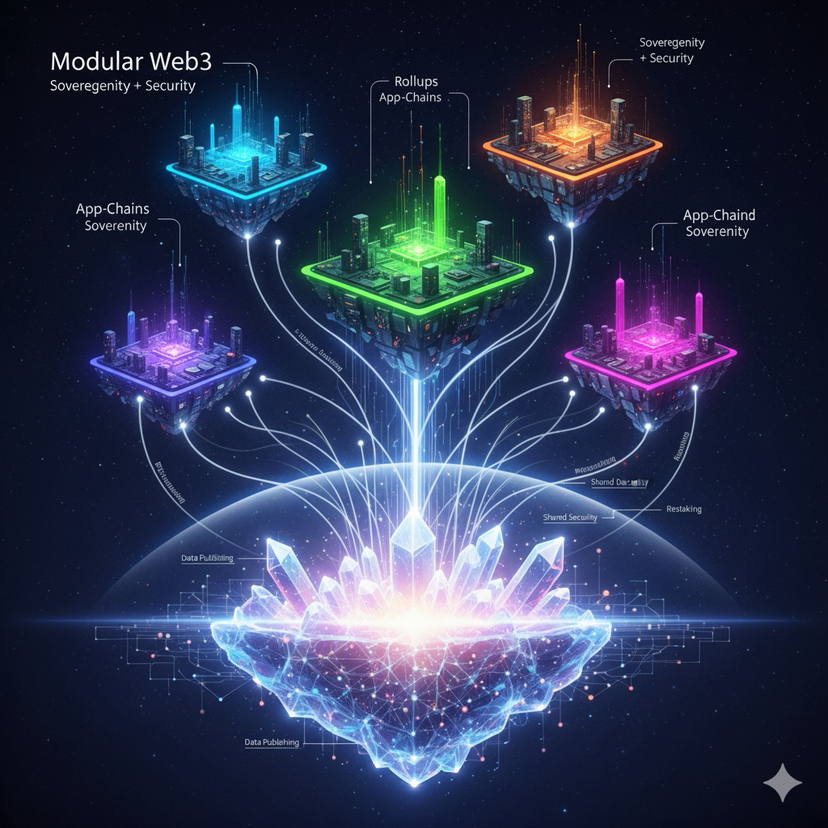Why "Modular Architecture" Is the Real Revolution (Version 2.0 - )
Friends, we are in the worst moment in history to be a blockchain that "does everything."
The old school was like a smartphone trying to be the camera, the GPS, the processor, and the internet service all at once. The result: slow, expensive, and it crashes (what we call the monolithic model). Web3 was stuck in the compromise between security and speed.
The new school is the Modular Architecture, and it is dismantling Web3. It is not an incremental improvement; it is a strategic divorce. Here I explain why this is the most important thing you will see in 2024 and 2025.
1. The Art of Decomposition
Forget about chains that juggle. Smart projects now focus solely on one thing.
The monolithic model forced each chain to handle Execution, Consensus, Settlement, and Data Availability simultaneously. It was a system doomed to bottleneck. Modularity breaks that trade-off.
Now, functions specialize. On one hand, we have Rollups (the Execution Layer) that are dedicated exclusively to processing transactions at breakneck speed. On the other hand, projects like Celestia (or the future of Ethereum) focus solely on Data Availability (DA). They are like a giant decentralized library. Rollups simply upload proof of their work to this library.
The technical ingenuity lies in the fact that Rollups inherit the security of Layer DA without having to pay the full rent. Security is no longer tied to the speed of execution.
2. Capital Demands Guarantee
This is not just speed; it's a shift in the economy of risk and trust.
The concept of Restaking (with platforms like EigenLayer) is the masterstroke. Ethereum has billions of dollars locked up; this is the largest and safest capital in Web3. EigenLayer allows that capital to be "re-staked" to secure other modular services (oracles, bridges, sequencers). They are selling Ethereum's trust as an economic guarantee product.
Moreover, modularity directly attacks fees. Why do you pay so much during peak hours? Because the demand for space in a monolithic block is extremely high. Modularity creates a competitive block space market. When there are more DA providers, the price to publish your transactions plummets. Investor capital loves efficiency.
3. The Freedom to Choose Your Law
This is the part people don't understand, and where you can shine as an analyst. It's the paradigm shift of sovereignty.
Previously, if a community was unhappy with the rules of a blockchain, it had to hard fork or move, sacrificing security and liquidity. The modular model allows you to create your own App-Chain (your own Rollup) with your execution rules, your fees, and your own token, but without losing Ethereum's security.
Decentralization used to mean a sacrifice (more slowness, more risk). Modularity breaks that trade-off. It gives you political freedom (sovereignty) to have your own state, along with the military security (L1 consensus) of the larger ecosystem.
We are not looking for a single chain that controls us all. We seek an ecosystem of thousands of consciences (sovereign App-Chains) that share a single immutable data reality.
📣 Modularity is the maturity of Web3. It teaches us that power is not in accumulating functions, but in synchronizing them intelligently. The future is not a super-chain; it is a symphony of specialized layers that, together, are unstoppable.
❤️ Like, quote, and share to expand this vision, because the next sovereign App-Chain could be yours.



